What’s That Screeching?
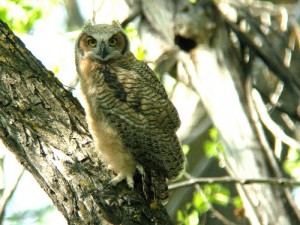
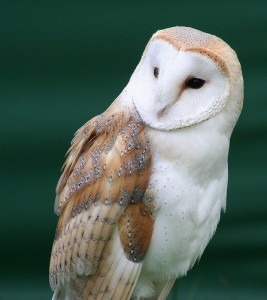
Around this time of year, I tend to get a lot of questions from people who want to know what kind of bird might make frequent loud harsh screeches at dawn, at dusk, or in the middle of the night. In most of the cases I’ve been able to solve, the culprit has turned out to be a young Great Horned Owl — one of the most vocal youngsters in the avian world (though one of the least vocally skilled, if I may be so bold as to say so).
However, back when I first started tracking these screeches to their source, I was usually hoping for a Barn Owl. And in areas where both species are possible, I think that a number of birders may regularly misidentify the shrieks of young Great Horneds with the “shhhhk!” of the Barn Owl. Thus, it seemed like a good idea to post on how to tell these two (rather unpleasant) sounds apart.
Great Horned Owl
I tend to associate the shriek of Great Horned Owl with young birds, but according to the BNA account, it can also be given by adult males and, especially, adult females. Juveniles shriek while still in the nest, and continue shrieking on a regular basis until at least December or January. The shriek is usually short (half a second or less), typically slurred either up or down, and almost always sounds at least partially squeaky (as evidenced by the banding on the spectrograms):
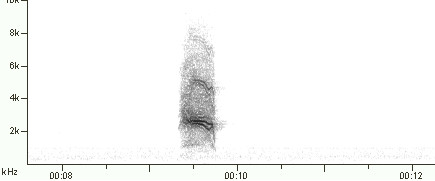
(Click here to listen to the above recording at the Macaulay Library.)
The above recording is typical in that the sound is mostly noisy, but partly voiced — in this case, even slightly polyphonic. The end result is a call that sounds like an inhaled hoarse scream.
Here’s a fairly similar example, from a bird still in the nest (with a Say’s Phoebe in the background):
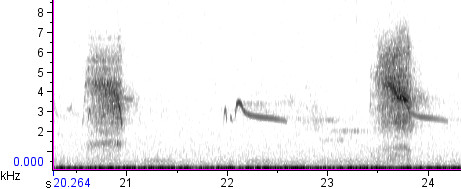
Meanwhile, the following recording helps demonstrate how variable this vocalization can be, even within individuals. It was recorded from a bird that appeared to be an adult, though given the late date it may have been a first-year bird that had recently acquired adult plumage.

Besides being strongly upslurred instead of downslurred, these calls (particularly the first one) are also less noisy, dominated by bands on the spectrogram, giving them a tone quality that is squeakier and less like television static. The “squeaky” quality and the strong inflection are two of the best ways to tell a Great Horned Owl from a Barn Owl.
Barn Owl
Although Barn Owl vocalizations are just as variable as those of Great Horneds, the “classic” Barn Owl screech is fairly distinctive: longer than a Great Horned shriek (up to a second long or more), and consisting mostly of noise, neither upslurred nor downslurred, perfectly horizontal on the spectrogram and very lightly banded, if at all. The call may sound like loud television static that is abruptly turned on and then off.
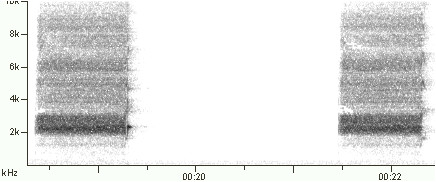
(Click here to listen to the above recording at the Macaulay Library.)
Note that each call above ends with a very brief squeak, distinctly audible in this close-range recording. Many Barn Owls, but by no means all, sound this way. Here’s an example of shorter calls devoid of squeaks:
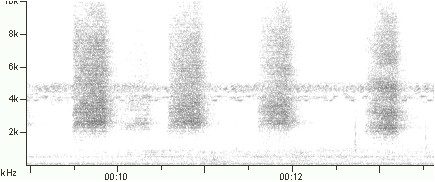
(Click here to listen to the above recording at the Macaulay Library.)
As always, we should beware individual, geographic, and age-related variation when identifying owl shrieks. Here’s a bird from Ecuador that sounds much higher-pitched and distinctly upslurred. It still has the hissing, non-squeaky tone quality typical of the species, but if such a bird were to vocalize in North America, it would make identification somewhat more challenging:
I hope this post is helpful for those wishing to make sense of the shrieks they’ve been hearing in the night.
4 thoughts on “What’s That Screeching?”
I found this really helpful. I heard and recorded some shrieking owls in eastern Washington and in Montana this summer that I could not identify. In the Montana case, I found some large gray fluffy fledglings but I still don’t know if they were Great-horned or Barred Owls. Does anyone know if young Barred Owls also shriek? My recording sounds a little different from the ones posted here.
Glad you liked it, Andrew. The Birds of North America account on Barred Owl indicates that they do indeed shriek: “Older young, up to 4 mo of age, beg food from parents by making a regular squeaking sound that verges on a hiss.” I haven’t gone looking for any recordings of young Barreds yet…it’ll go on my “to do” list!
Thanks, very informative! I win a small point w/ my brother, I have Horned Owls (slurred shrieks) not Barn Owls….
I am just getting to know this website and find the topics to be excellent.
All of the young Strix owls have a great screeching begging call. Typically rather short it is often ascending and raspy. I first learned this at Churchill filming Great Gray Owl young and remembered that Barred Owls had a similar but also species different call. Perhaps at this age, a genus’ similarities stand out.
Keep up the good work.!
Comments are closed.